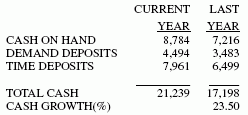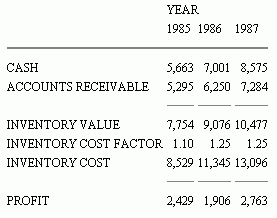An FML report can refer to explicit columns, as well as explicit rows. You can refer to columns using:
- Column numbers.
- Contiguous column notation in RECAP expressions. For example, (2,5) represents columns 2 through 5.
- Column addressing.
- A factor to represent every other column, or every third column, and so on.
- Column notation to control the creation of column reference numbers.
- Column values.
Example: Applying Column Declarations in RECAP Expressions
The following request generates an FML matrix with four rows and three columns of data.
DEFINE FILE LEDGER CUR_YR/I5C=AMOUNT; LAST_YR/I5C=.87*CUR_YR - 142; END TABLE FILE LEDGER SUM CUR_YR AS 'CURRENT,YEAR' LAST_YR AS 'LAST,YEAR' COMPUTE CHANGE/I5C = CUR_YR - LAST_YR; FOR ACCOUNT 1010 AS 'CASH ON HAND' OVER 1020 AS 'DEMAND DEPOSITS' OVER 1030 AS 'TIME DEPOSITS' OVER BAR OVER RECAP TOTCASH/I5C = R1 + R2 + R3; AS 'TOTAL CASH' END
Both the columns of the report, as well as the cells of the matrix, can be referenced in another FML report.
The output is shown in the following image.

For example, you could use the value 6,499 in another FML report by referring to column 2, row 3. For more information, see Referring to Cells in Calculations.



